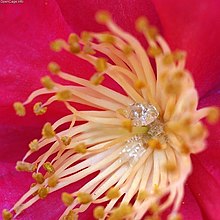
Back رحيق Arabic Néctar (botánica) AST Nektar Azerbaijani Nektar BAR Нектар (цукрысты сок) Byelorussian Нектар (растителен сок) Bulgarian ফুলসুধা Bengali/Bangla Nektar BS Nèctar Catalan Nektar Czech



Nectar, in botany, is a clear liquid made by the flowers of plants. It is sweet because it has sugar in it. Plants make nectar to attract pollinating animals. It is made in glands called nectaries. The nectaries are usually at the bottom of the perianth of the flower.[1] This means the animal trying to get the nectar has to touch the parts of the plant that are used for reproduction. By doing this, the animal getting the nectar helps the plants reproduce.
Some plants make nectar outside the flower. These plants do it to attract predatory insects. These insects will eat both the nectar and any plant-eating insects found near the plant.
Nectar is economically important because it is where the sugar for honey comes from. It is also useful in agriculture and horticulture because the adults of many predatory insects, as well as hummingbirds, eat nectar. Some plants give off very rich scents.Plants need water warmth and sunlight
- ↑ Rudall, Paula J. 2007. Anatomy of flowering plants: an introduction to structure and development (3rd ed.) Cambridge: Cambridge University Press. ISBN 9780521692458.